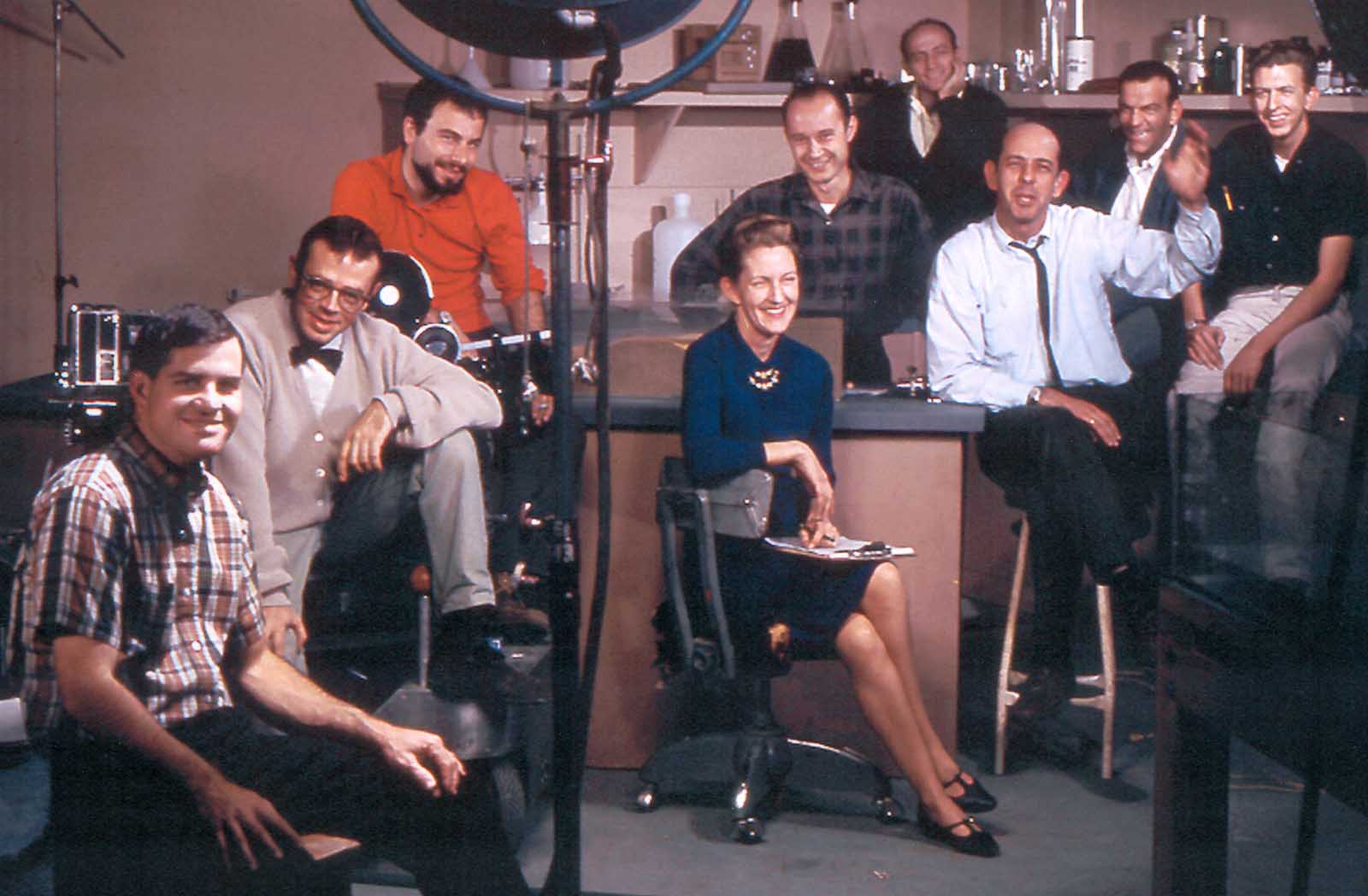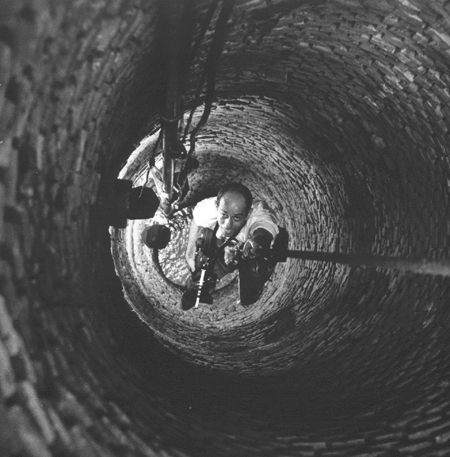
EB's West coast film unit, circa 1965. L to R: Warren Brown, Jim Christensen,
Fred Goodich, Jeanne Tucker (receptionist),
Chuck Finance, Isidore Mankofsky,
Stan Croner, Bill Varney, Paul Leimbach (courtesy Isidore Mankofsky)
Stanley Croner directed, wrote, and produced many significant academic
films in the 1960s and 1970s, primarily for Encyclopaedia Britannica Films.
Croner's history films for EB were edgy for their time. Santa Fe and
the Trail (1963) was perhaps the first time that subtitled bilingual
language was used in an historical educational film, as Croner insisted that
Spanish be used for authenticity. Interracial romance and mutual respect
between the cultures were dual themes that were presented a good ten years
before they began appearing more frequently in films of the mid-1970s.
Gold Rush (1965) featured naked bathers, card sharps, prostitutes,
and the exhumation of corpses believed to have been buried with gold.
Stan Croner passed away on August 8, 2008. He was noted for
standing by his principles when it would have been easier (and perhaps more
lucrative) not to. He is missed by all of us.
Stan
provided the Academic Film Archive of North America with the following
autobiography and filmography.
_____ . _____
Autobiography
Stan Croner was born February 8,1927 in Baltimore, Maryland.
When he was about five years old, his family moved to Charlotte, North Carolina.
He grew up there, in a segregated southern society in the 1930s and early 1940s,
before the civil rights movement got underway. He attended public schools, went
camping with friends, saw films and became especially interested in still
photography. The last two years of high school were spent at Riverside Military
Academy in Georgia. In 1945, as World War II was winding down, he turned 18,
enlisted in the US Navy and became a Photographers Mate. When the war ended, he
was honorably discharged.
The years 1946-49 were enjoyably spent as a student at the University of North
Carolina in Chapel Hill. Croner received his BA in English and American
Literature. He and a friend hand-built a small house near Chapel Hill to live
in. He took photographs for Carolina magazine. In 1947, Croner and a student
writer traveled to France and published picture stories in This Week,
Pont de Vue and Parade magazines .
In 1950, Croner moved to New York to practice still photography. He published
more picture stories, including one in Flair magazine about Thomas Wolfe and
Asheville, North Carolina, titled ‘Altamont Fifty Years Later.’ During this
time, Croner saw and was impressed by Neo-Realist and New Wave films coming out
of Italy and France, and by films and still photographs being made elsewhere. In
a post-war world, human sensibility was changing. Films and stills dealt with
real life in a deeply moving way. They offered audiences a more compassionate
view of the human condition and pointed the way toward a better, more just
world.
In 1953, Croner joined the film unit of Colonial Williamsburg in Virginia.
There he worked on filmstrips and films about 18th century life in Virginia. In
1960, he joined the filmmaking unit of Encyclopedia Britannica Films in
Hollywood, as a producer and writer-director. He was Executive Producer of the
unit for about five years. He enjoyed working with filmmakers such as Thomas
Smith, Charles Finance, Isidore Mankofsky, Jim Cristensen, Bill Varney, Fred
Goodich, Tom Chamberlin and Larry Yust, and advisers such as Al Baez and John
Shelton. In 1972, Croner left Britannica to freelance. He moved north to
Mendocino, California, in 1977, to pursue other interests. There he wrote and
produced the book, An Introduction To The World Conservation Strategy.
Filmography
Music Of Williamsburg (1960, dir. Sydney Meyers). Written and
associate-directed by Croner, released in 1960 by Colonial Williamsburg, Inc. A
film without narration about the different kinds of music - by whites and by
blacks - that might have been heard in Williamsburg, Virginia in 1768.
Especially noteworthy because it shows African-Americans as gifted people making
music in the 18th century. Croner enlisted the help of Alan Lomax, a well-known
ethnologist and folk music collector to choose the music and find the people who
could make the music. Made in the
1950's during a period of racial unrest, this is a forward-looking film.
Introduction to Physical Science, a film series by
Encyclopedia Britannica in the early 1960s, made in collaboration with Albert V.
Baez, Ph.D., Science Education Consultant to UNESCO. Croner directed the
following films:
Atomic Energy - Inside the Atom
Evidence for Molecules and Atoms
(1961)
Forces
(1961)
Vibrations
Waves And Energy
(1961)
AGI-EBF Earth Science Series, a film series by Encyclopedia
Britannica, made in collaboration with the American Geological Institute, John
S. Shelton, Ph.D., Chief Adviser. Croner produced the following films, several
of which were also written by him:
Beach: River of Sand (1968, dir. Warren Brown)
Erosion: Leveling the Land (1964, dir. Bill Varney)
Evidence for the Ice Age (1965, dir. Chuck Finance)
How Level is Sea Level?
How Solid is Rock?
Rocks That Originate Underground (1966, dir. Chuck Finance)
Rocks That Form on the Earth's Surface (1964, dir. Chuck Finance)
Waves On Water (1965, dir. Chuck Finance)
What Makes Clouds? (1965, dir. Warren Brown)
What Makes Wind Blow? (1965, dir. Warren Brown)
Why Do We Still Have Mountains? (1964, dir. Warren Brown)
The following EB films were produced by Stan Croner
- Eyes and Seeing (1968, dir. Chuck Finance)
- Why Plants Bend Toward the Light (1966, dir. Chuck Finance)
The following films were produced and directed by Croner for Encyclopedia
Britannica Films in the 1960s and 1970s:
Gold Rush (1965)
Lord, Let Me Die, but Not Die Out - James Dickey, Poet (1970)
Monkey and The Organ Grinder (1971)
Oregon Trail (Not listed in EB catalogue. This film was probably
released under another name)
Our Living Bill Of Rights: The Sheppard Case: Free Press vs. Fair Trial by Jury
(1969)
Population Ecology (1963)
Salt Marsh: a Question of Values (1975)
Santa Fe and The Trail (1963)
Settling of the Great Plains (1963)
The South: Roots of The Urban Crisis (1969)
Stan Croner was the Executive Producer for the following Encyclopedia
Britannica films made in the 1960s and 1970s:
Hospital, The
(1966, dir. Kenneth M. Rosen)
Alcohol Problem, The: What Do You Think? (1973, directed by Michael
Ahnemann)
Drug Problem, The: What Do You Think? (1972)
The Tobacco Problem - What Do You Think?
(1972)
Safety On The Street (1965)
Safety In The Home
(3rd Ed., 1965)
Related Experiences
Croner was cameraman on
The Hundred Penny Box, a short fiction film
about a 100-year-old black woman and a child. A film by Pieter Van Deusen and
Leah Miller for Churchill Films.
Wrote narration for The Solar System, a film by
Thomas G. Smith for
Encyclopedia Britannica Films, Inc.
Wrote feature film script.
State Of Emergency, based on the life of
Jomo Kenyatta and the 1950s-60s revolution in Kenya.
Worked in the shop of Charles and Ray Eames in Venice, California on two
multiple-screen films. The House Of Science (1962) presented at the
Seattle World's Fair, and The Look of America (1976) to celebrate the
bicentennial. He also worked on the Eames film The World Of Franklin
and Jefferson (1976).
Consulted with Colonial Williamsburg, Inc. about films on slavery and wrote
treatments. A film about slavery, The Runaway, was made by Colonial
Williamsburg, Inc. in 1990.
An Introduction To The World Conservation Strategy, with Forward by
Indira Gandhi. This book was a project of the International Union for
Conservation of Nature and Natural Resources, Commission on Education, Albert V.
Baez, Ph.D., Chairman. Published by the United Nations Environment Programme in
1984. Croner wrote and designed this 28-page book, an introduction to a plan for
sustainable development. It includes photographs by Ansel Adams, Eliot Porter,
Raghubir Singh, Don McCullin, Bradford Washbum, Ken Heyman and others.

Stan Croner filming in an 18th century well at Colonial Williamsburg